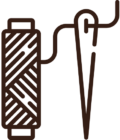Furniture
Textile in the interior sets the tone, enlivens the room, brings colors to the overall design palette, and creates its mood. Competently selected fabrics for your curtains, curtains, upholstery, and accessories, a skillful combination of style and colors in textiles, helps to highlight the advantages and hide the flaws of the interior.
Textiles have one big advantage – they are easier to change than the decoration of the room. Therefore, it is better to make a neutral finish and revive it with bright textiles that can be easily replaced. By replacing curtains and pillows, you can easily change the “mood” of the interior.
Each style has its own textiles. When choosing textiles, the combination of fabrics in texture, color, and pattern is taken into account. The most commonly used combination of warm and cold tones compliment each other and maintain the overall atmosphere.
The arsenal of interior textiles includes a wide variety of fabrics. For upholstery, practical materials with high wear resistance are often used (tapestry, jacquard, velour, flock, microfiber, and nubuck).
Fabrics and styles for the manufacture of curtains are as diverse as the geography of the world, as their names suggest: Japanese (made from solid fabrics of fabric and multi-strip cornices), Roman (similar to blinds, but made from a single piece of fabric), Austrian (assembled with a curtain tape along the top edge into the gather and fall down in soft folds), French (lush, transparent draperies with many folds), London (cascading curtains made of soft fabric, gathered with ribbons in a garland), Italian (pulled together with cords running diagonally to the ends of the cornice), Chinese (in the size of the window armhole with a tape sewn on both sides).
In the rest of the textile accessories in interior design, preference is given to exquisite silk, natural cotton or linen, noble velvet, and sophisticated chiffon.
Textiles are used for any type of room. In the living room, the walls are decorated with textiles, it is used for curtains, furniture upholstery, covers, capes, bedspreads, rugs, and pillows. For the kitchen, this can be curtains on windows, curtains on cupboards, seats on chairs, tea towels, napkins, and tablecloths.
Textiles are indispensable for the bedroom, where decoration with fabric is used for walls, headboards, poufs, and chairs. In the children’s room, textiles should be natural, comfortable for children, create a bright and cheerful mood, be it play rugs, bedspreads, bed linen, curtains, or other accessories.
